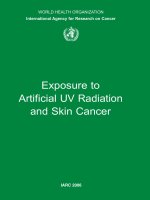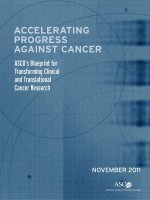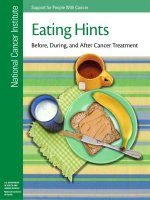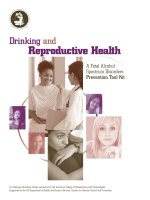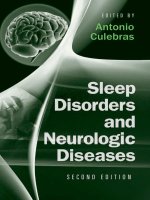Nutrition, Exercise and Prostate Cancer potx
Bạn đang xem bản rút gọn của tài liệu. Xem và tải ngay bản đầy đủ của tài liệu tại đây (649.34 KB, 32 trang )
Nutrition, Exercise and
Prostate Cancer
Authors
David Heber, MD, PhD
Professor of Medicine and Public Health
Director of the UCLA Center for Human Nutrition
University of California, Los Angeles
Stephen J. Freedland, MD
Associate Professor of Urology
Duke University Medical Center
Lee W. Jones, PhD
Associate Professor, Department of Surgery
Duke University Medical Center
William G. Nelson, MD, PhD
Marion I. Knott Director and Professor of Oncology
Director, The Sidney Kimmel Comprehensive Cancer Center
Johns Hopkins School of Medicine
The Prostate Cancer Foundation (PCF) was founded in 1993 to find better
treatments and a cure for recurrent prostate cancer. Through its unique
model for soliciting and selecting promising research programs and rapid
deployment of resources, the PCF has funded more than 1,500 programs
at nearly 200 research centers in 20 countries around the world.
As the world’s leading philanthropic organization for funding prostate-cancer
research, the PCF is now a foundation without borders. Its advocacy for
increased government and private support of prostate cancer programs
has helped build a global research enterprise of nearly $10 billion.
Today, 40 percent fewer men are dying from prostate cancer compared
to what was once projected. The PCF is a force of
HOPE
for more
than 16 million men and their families around the world who are currently
facing the disease.
Studies have shown that lifestyle — especially nutrition and exercise — has
a significant influence in prostate cancer prevention and treatment. This guide
presents the latest information for men who want to maintain a lifestyle that
promotes prostate health.
Nutrition,
Exercise
and
Prostate
Cancer
Table of Contents
2 Introduction
3 Understanding the Links Between
Nutrition, Exercise, and Prostate Cancer
3 Effects of Oxidation and Inflammation
4 The Contribution of Carcinogens
5 Effects of Excess Sugar
6 Putting It All Together
8 Obesity and Metabolism — Where We
Went Wrong
9 The Metabolic Syndrome
9 Effects of Excess Body Fat
10 Effects of Muscle Loss
11 Nutrition at the Molecular Level
12 The Contribution of Antioxidants and
Phytochemicals
12 The Color System of Antioxidants
15 The Delicate Balancing Act of
Supplement Use
15 Avoiding Toxicity and Overdosing
16 Making the Smart Choice
18 Implementing a Plan for Success
18 Building Strong Muscles
19 Restoring a Healthful Caloric Balance
20 Incorporating Good Nutrition and
Exercise Into Your Everyday Routine
20 Reviewing the Benefits Stage by Stage
20 Adopting a Healthy Approach
23 A Commitment to Change
23 The Decision to Change
25 The Four S’s of Success
27 Suggested Reading
Nutrition, Exercise and Prostate Cancer
T
reatment options for prostate cancer are
more effective than ever before. Yet, for
many men, the diagnosis and treatment
of cancer brings to their attention the need to
change their diet and exercise behaviors. While
the primary focus of the prostate cancer survivor
is to live a life free of cancer, more men are
beginning to realize that a healthy diet and
regular exercise can be an important step toward
preventing other diseases that commonly occur
with aging, including heart disease and diabetes.
Exciting new data suggest that this same approach
may also slow prostate cancer growth. This
guide takes the best published evidence from
population studies, basic science, and limited
human studies, and puts them together in ways
that make practical sense — with the overall goal
of helping you achieve “thrivership” not just
survivorship.
What is thrivership? The Merriam-Webster
dictionary defines thriver as one who progresses
toward a goal despite circumstances, and flourishes.
The diagnosis of prostate cancer can lead you in
one of two directions. Some will react to this
diagnosis with a sense of resignation and fatalism.
This view can lead to helplessness — waiting for the
other shoe of cancer recurrence or progression to
drop. On the other hand, thrivership puts you in the
driver’s seat — making you as vital to your care and
treatment as any doctor or nurse. You may have had
prostate cancer, but now you are in charge of your
life, adopting new healthy habits and enjoying each
day to its fullest. As a prostate cancer thriver, you can
use the latest knowledge about nutrition and
exercise to improve your overall health and quality
of life. Your diagnosis of prostate cancer can be the
beginning of a healthier lifestyle.
As a prostate cancer thriver, you can use
the latest knowledge about nutrition and
exercise to improve your overall health
and quality of life
A working group of the leading experts and
scholars in nutrition, exercise, and prostate cancer
were gathered from across the United States and
asked to provide their advice to us in developing
this guide. It is our hope that you will benefit from
the recommendations in this guide for a healthy
diet and regular exercise, and that you will achieve
a better understanding of the roles of diet and
exercise in the prevention of age-related diseases,
as well as in the recurrence and progression of
prostate cancer.
2
Introduction
Nutrition, Exercise and Prostate Cancer
Understanding the Links Between Nutrition,
Exercise, and Prostate Cancer
3
O
ur modern society is characterized by a
lifestyle with low levels of exercise coupled
with consumption of foods that are high
in calories, fat, sugar, and salt. But your body still
responds in the only way it knows — it stores excess
food as fat to prepare for times of prolonged
starvation. Of course, because prolonged starvation
typically does not happen in modern society, this
safety mechanism means that we just continue to
gain weight and store more fat.
This excess fat, especially the fat around the middle
of your body, has been associated with an increased
risk of many diseases, including prostate cancer,
and particularly aggressive prostate cancer. But you
don’t have to be 50 pounds overweight to suffer the
ill effects of excess body fat. Body fat is actually
an organ with functions. It secretes hormones and
specialized proteins that can increase inflammation
and oxidation in the cells of your body — two
natural processes that are strong contributors to the
development and progression of prostate cancer.
Effects of Oxidation and Inflammation
Oxygen is essential to life, but the chemistry of
oxygen and oxidation drives cancer development.
Oxidation is a normal chemical reaction that occurs
when free radicals form within the cells of the
prostate. Each oxygen atom contains two electrons
that cling together. When heat or light breaks apart
the atom, the electrons are separated, leaving
unpaired oxygen radicals. These radicals are free to
roam around and initiate a process of breaking
down normal cellular structures, causing damage
and promoting the development of cancer.
The more free radicals present, the more cancer-
causing damage occurs.
This process is similar to what happens during the
browning of an apple after it is sliced open and the
flesh of the apple is exposed to the oxygen in the
air. The oxygen atoms in the air interact with the
sugar in the apple, forming oxygen radicals. These
radicals break down the flesh of the apple, or
oxidize it, and the apple begins to rot.
As long as the outer peel of the apple protects
the inner flesh from oxygen, it is not oxidized.
But when protective “antioxidants” are removed,
the damage from oxidation is allowed to occur
unimpeded. Likewise, our bodies have many
sophisticated defenses against oxidation. But
when these defenses break down, cancerous cells
form and are allowed to grow.
One of the most common causes of the loss
of protective antioxidants is inflammation, a
biochemical process that your body initiates
when fighting off an infection. If the body senses
invaders, such as bacteria, white blood cells are
mobilized to go to the site of the invasion and to
release oxygen and nitrogen radicals to help kill the
invaders. Unfortunately, if they remain unchecked,
these same oxygen radicals can also break down
normal tissue and promote the development of
cancer. Oxygen radicals damage normal DNA,
causing errors that allow cancer growth.
In fact, investigators have noted the presence of
inflammatory cells in virtually all prostate cancer
tissue that is removed surgically, and have found that
inflammation leads to the atrophy, or wasting away,
of normal prostate tissue adjacent to precancerous
and cancerous areas of prostate tissue.
Based on these and other observations, evidence is
mounting that inflammation and oxidation play
key roles in the development of prostate cancer.
Why is this important? Because although other
contributory factors such as aging and altered
hormone secretions are difficult or impossible to
change, nutritional and exercise habits that reduce
the development of inflammation and oxidation
can be changed.
Although some factors that contribute to prostate
cancer are dicult or impossible to change,
nutritional and exercise habits that reduce
inammation and oxidation can be changed
There are many anti-inflammatory and antioxidant
substances found in colorful fruits and vegetables,
whole grains, and spices — nearly all of which are
absent from the processed foods that rely on sugar,
salt, and fat for flavor. By focusing your diet on
fresh fruits and vegetables, ocean-caught fish, and
whole grains, you can increase the protective anti-
inflammatory components of your diet and begin
to benefit from their effects.
For example, tomato-based products such as
soups, pasta, and juices can increase levels of
the antioxidant lycopene in the prostate gland.
Drinking beverages such as pomegranate juice
and green and black tea can increase levels
of antioxidant-containing polyphenols. The
cruciferous vegetables such as broccoli,
Brussels sprouts, bok choy, wasabi mustard,
and horseradish all contain substances that
may induce protective proteins in your liver and
tissues, while vitamins, minerals, extracts of fruits
and vegetables, herbs, and spices can all act
against both oxidation and inflammation.
Finally, recent research has suggested that regular
exercise may be one of the best natural antioxidants.
Regular exercise causes many changes in your body
that help reduce circulating levels of reactive oxygen
inflammation. Beyond burning calories, endurance-
type exercises, such as walking, running, cycling, and
swimming, are particularly effective at increasing the
body’s natural levels of antioxidants, eliminating
inflammatory molecules that drive cancer.
Endurance-type exercises, such as walking,
running, cycling, and swimming, are
particularly eective at increasing the
body’s natural levels of antioxidants
The Contribution of Carcinogens
Inflammation and oxidation are two of the body’s
natural processes, which, when they are allowed to
proceed unchecked, can influence the development
of prostate cancer. But external substances also play
an important role — and can also be thwarted by
keeping to a healthy diet.
A carcinogen is a chemical that directly or indirectly
causes or leads to more aggressive forms of cancer.
Hundreds of chemicals have been definitively linked
to cellular changes that lead to cancer development,
and hundreds more have been implicated in
processes that might be involved. In today’s
industrial society, it’s hard to avoid all exposure to
carcinogens. But by focusing on a healthy diet and
on healthy eating practices, you can avoid increasing
your exposure to carcinogens that contribute to
the development of prostate cancer.
For example, overcooking of any type of meat
at very high temperatures produces a set of
Nutrition, Exercise and Prostate Cancer
4

